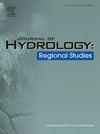Prediction of runoff in the upper reaches of the Hei River based on the LSTM model guided by physical mechanisms
IF 4.7
2区 地球科学
Q1 WATER RESOURCES
引用次数: 0
Abstract
Study region
The upper reaches of the Hei River.
Study focus
To improve the accuracy, interpretability and physical consistency of LSTM models for predicting streamflow, we have constructed a physically dominant loss function in the LSTM model based on the monotonic physical mechanism of rainfall-runoff in the water balance. The new model (physics-guided LSTM model, PG-LSTM) was applied to predict streamflow in the upper reaches of the Hei River, and its accuracy and physical consistency in streamflow prediction were analyzed.
New hydrological insights for the region
The PG-LSTM model was successfully applied to the upper reaches of the Hei River, and the accuracy was evaluated by the Nash–Sutcliffe efficiency coefficient, root mean square error and Pearson correlation coefficient. The physical consistency of the model was evaluated by the volume error, relative error, and peak flow relative difference. The results showed that the PG-LSTM model had higher accuracy and physical consistency than the traditional LSTM model. The fitting accuracy between the measured and predicted values was 0.97, which is higher than that of the traditional LSTM model (0.89). In addition, the closer the subbasin was to the outlet of the basin, the better the effect of the PG-LSTM model. This model improvement method demonstrated high streamflow prediction accuracy and interpretability, providing a scientific basis for water resource planning and management.
求助全文
约1分钟内获得全文
求助全文
来源期刊

Journal of Hydrology-Regional Studies
Earth and Planetary Sciences-Earth and Planetary Sciences (miscellaneous)
CiteScore
6.70
自引率
8.50%
发文量
284
审稿时长
60 days
期刊介绍:
Journal of Hydrology: Regional Studies publishes original research papers enhancing the science of hydrology and aiming at region-specific problems, past and future conditions, analysis, review and solutions. The journal particularly welcomes research papers that deliver new insights into region-specific hydrological processes and responses to changing conditions, as well as contributions that incorporate interdisciplinarity and translational science.
 求助内容:
求助内容: 应助结果提醒方式:
应助结果提醒方式:


